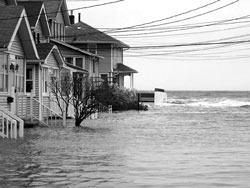The University’s communication department and center for the arts presented a film documentary called “Shored Up” on September 9, which explained the effects of sea level rise.
“Shored Up,” directed by Ben Kalina, was part of the “On Screen In Person” film festival. A panel discussion immediately followed the screening.
According to the film, the United States is a coastal country, meaning that a high percentage of the population is living close to the coast. Throughout the film, the negative repercussions that result from this situation were discussed.
The documentary states that six inches of the shoreline are lost every year in New Jersey. This is due to the fact that the shoreline is interacting with infrastructures.
“What documentaries like “Shored Up” provide is a much more detailed and nuanced understanding of a topic. This film really opened my eyes to the complexities of this issue,” Andrew Demirjian, a Specialist Professor in the communication department, said.
There are 123 million Americans inhabiting the shore areas, according to the “Shored Up” website. Shore towns are driven by locals and tourists that keep the economies thriving. This becomes an issue when the area cannot sustain the demands that such an extreme number of human presence puts on the region.
More and more homes are being built on the shore, which puts the homes in a hazardous position if the water were to come up too high.
To make room for the homes, and to keep them safe from damage, ocean groins [man-mande structures that restrict ocean current] are built perpendicular to the shoreline in order to keep the water and sand in place. Nevertheless, this causes stress to the environment and disrupts its natural cycle.
The sea level begins to rise as it is pushed farther from the shoreline. When this occurs, the water begins to melt the arctic icecaps that cause the sea level to rise higher, according to the documentary. The film went on to explain that as this cycle continues, the ocean pushes back, causing catastrophic events such as Superstorm Sandy.
To alleviate this problem, sand [taken from other parts of the ocean] is placed between the homes on the shoreline and the water. However, this process is very expensive and lasts only until the sand is washed away by the water.
The sand replenishment process is an expense to locals whose tax dollars pay for the replenishment, the film explained.
Elisha Hendelson, a senior who attended the documentary said, “The movie made me realize that the more we try to fight with Mother Nature, the more she tries to fight us back.” She added, “In the film, one woman [Deborah Whitcraft, former mayor of Beach Haven] said what we’re doing to the ocean is like putting a band aid on a hemorrhage; it will cover it up but it won’t fix the problem.”
A panel discussion including Tony MacDonald, Director of the Urban Coast Institute at the University, Dr. Norbert Psuty, Professor Emeritus Institute of Marine and Coastal Sciences at Rutgers University, John Weber, Mid Atlantic Regional Manager of the Surfrider Foundation, and Ben Kalina, the director of the film each responded to questions. At this time, the audience was able to ask unanswered questions, provide their viewpoints and share their personal experiences with sea level rise.
Other events in the “On Screen In Person” film festival like the Shored Up documentary give students the opportunity to learn more about topics relating to their majors and their interests.
“I think that after attending this film I will live conscious of this information and have more understanding of what is going on with the environment,” said Ashley Morrow, a freshman social work major.
PHOTO TAKEN from www.thegaurdian.com




